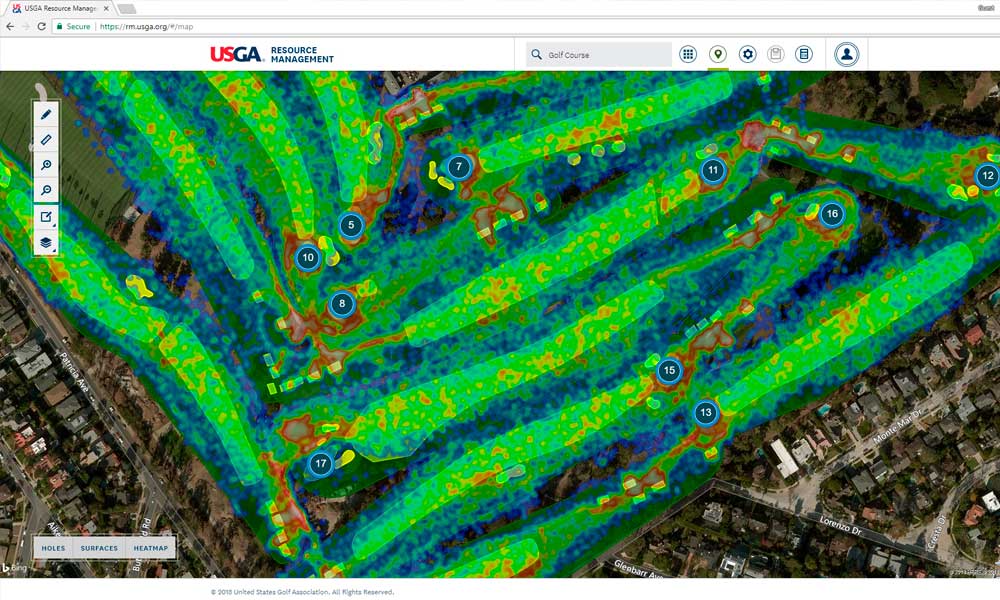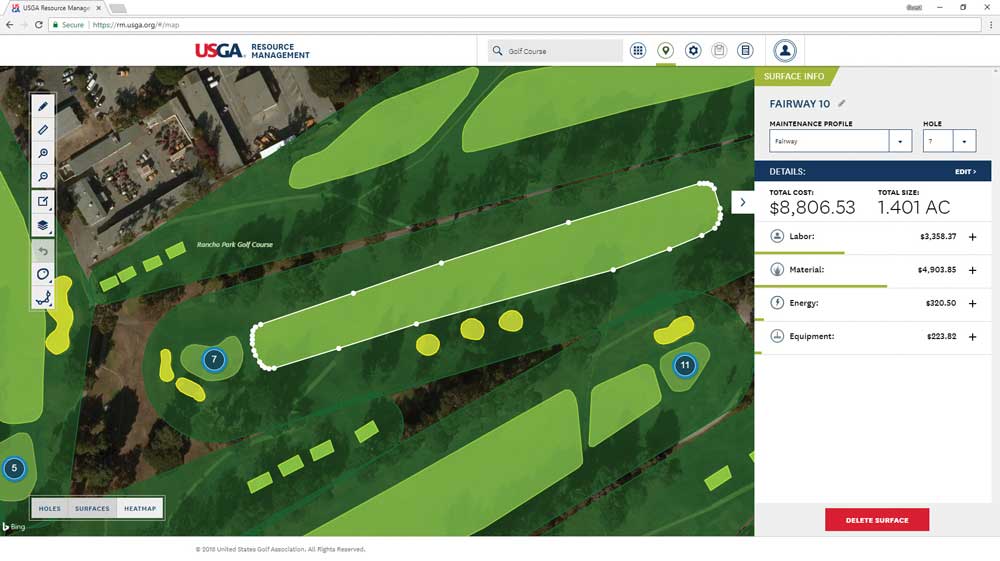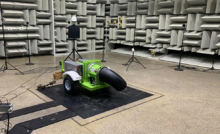USGA Seeks to Optimize Maintenance Costs through Revolutionary New Tool


Patrons often view golf courses as mere fields of play. But insiders know that those well-tended expanses are, in fact, businesses that in today’s world must constantly adapt and find ways to offset increased operational costs in the face of diminishing revenues. There’s a reason that the area in which we’re involved is called the golf “industry.” And right now, our business model needs help.
In an effort to help golf facilities manage maintenance costs, the United States Golf Association has been developing a new web- and a map-based tool called Resource Management. It’s an ambitious undertaking, one involving devoting many late-night hours at its headquarters in Far Hills, N.J., the hiring of new software engineers, and, according to one USGA staffer, “lots of sweat equity.”
That’s because of the project’s massive scope, which involves the visualization of every golf course in the U.S., with the various surfaces – tees, fairways, bunkers, and greens – identified at each layout. The system also features a key interactive component, one that entails golfers carrying in their pockets a thumb-drive-sized GPS tracking device that can be uploaded to show where they went during the round.
That usage information – with the times and locations of golfers indicated by red dots superimposed on a hole – tells the story of where play actually occurs. This “heat-map” data, which the USGA says indicates the true in-play and out-of-play areas, provides a realistic baseline for how superintendents can alter tee placements, fairway widths, bunkers, and other elements of their courses. This will help facilities streamline maintenance efforts and allocate costs to the areas that have the greatest impact on a golfer’s experience.
The USGA has convinced the benefits of Resource Management will play an important role as the game of golf evolves over the next few years. Its director of Partnerships, Outreach and Education for Research, Science and Innovation, Hunki Yun, says, “We’re pretty bullish on this and feel it has a great utility for golf course managers and superintendents.”


Interested operators and superintendents can go to rm.usga.org and sign up for the program, which will be released, according to Yun, in “late 2018.” As with other ambitious new projects involving many variables, he expects Resource Management will be tweaked based on user feedback.
The tool provides average costs for the different tasks associated with golf course maintenance, including irrigation, fuel, labor, chemicals, and so forth. But, because these numbers vary greatly from course to course and region to region, the superintendent can enter costs tailored to his facility, making the application customizable.
The heat maps from golfers delineating high-traffic areas provide a wealth of useful information. And, because of the thought and planning that went into the system’s architecture, that data provides verifiable insights after just a few days of golfer tracking. It also allows superintendents and facility managers to perform “what-if” analyses and develop models that quantify the financial impacts of proposed changes in the maintenance.
Those features comprise the essence of the Resource Management program. After all, if parts of the golf course aren’t really used or not part of the average golfer’s playing experience, why devote expensive resources to those areas? If the few players who use the way-back tees don’t place their drives in the more highly traveled (and maintenance-intensive) areas, why keep those starting blocks open on non-tournament days? Conversely, if the forward tees aren’t routinely resulting in second shots within the normal fairway junctures, why not adjust them accordingly? And if out-of-play bunkers aren’t being hit into, why maintain them as part of the crew’s daily-duty checklist?
The program allows superintendents to review the traffic on each hole and “grab” the edges of fairways with their computer mouse to adjust or shrink fairway widths based on where play is actually occurring, thus reducing the sizes of areas normally mowed, irrigated, and maintained. They can direct staff away from these sections on the golf course to focus on the oft-used areas, optimizing manpower and resources.
The USGA, whose traditional focus has been on overseeing the Rules of Golf, its championships, GHIN handicapping and agronomic services, has employed several “beta-test” courses around the country to evaluate the new tool. There are large variations in maintenance costs (i.e., access to irrigation water in drought-ridden Southern California vs. the rainy Pacific Northwest, and minimum-wage scales). And because of these variances, the association is compiling case studies to give the program enough versatility to show that it has nationwide applicability, all predicated on particular attention to maintenance practices that can be reduced in cost, based on real-time course usage.
The organization has reached out to the Golf Course Superintendents Association of America and the American Society of Golf Course Architects, which might use the tool’s feedback features for course remodels and renovations to better direct play and economize footprints. According to Yun, several architects are now “playing around with it.”
To help keep everyone at a golf course (superintendent, general manager, and green committee members) on the same page, the USGA allows multiple log-ins to Resource Management so the tool can be shared at a single golf facility. The upshot is that, by quantifying actual maintenance costs by scientifically identifying the most-used areas of a golf course, interested parties can readily grasp the need to devote available resources to the primary in-play areas.
“As the cost of maintaining a golf course continues to rise, facilities increasingly need smart tools and data to operate efficiently,” said Rand Jerris, the USGA’s senior managing director of Public Services, when the program was first unveiled in March 2017. “For nearly a century, the USGA has helped improve golf course operations and golfer experience through educational materials, research, and agronomic and environmental consulting services. This investment in technology is an important next step, which will help facilities realize immediate benefits through simple and effective behavioral changes.”
Adds Darrell J. Marcinek, director of golf maintenance for the Somerset (N.J.) County Park Commission, “Information and data are critical in our business. This tool would take the guesswork out of our budgeting, and the end-product will be better for the golfers because we’re maximizing our limited resources.
“The USGA is at the forefront of our industry,” adds Marcinek. “There’s nothing on the market that I’m aware of that does what this tool does.”
The USGA has not yet developed a price structure for its Resource Management initiative. But, according to Yun, it and the GPS devices used by golfers at participating courses will be affordable. “Profit is not the USGA’s motive,” he said. “Our mission is to help golf courses with their maintenance costs, which are a long-term threat to the industry. If current trends continue over the next 10 to 20 years, it’s going to be tougher for golf courses to be financially viable,” without a tool such as this.
The ultimate goal of Resource Management is to make its benefits available to the estimated 35,000 golf courses worldwide. The USGA hopes that will improve cost-efficiency and productivity to help secure a more economically-sound future for the Royal & Ancient Game.
Showing where golfers truly play should help a facility’s bottom line while enhancing the overall experience of its patrons.
Jeff Shelley has written and published nine books as well as numerous articles for print and online media over his lengthy career. Among his titles are three editions of the book, “Golf Courses of the Pacific Northwest.” The Seattle resident was the editorial director of Cybergolf.com from 2000-15. For seven years he served as the board president of First Green, an educational outreach program that is now part of the Golf Course Superintendents of America and Environmental Institute for Golf.
Read other Jeff’s Article – https://www.golfcoursetrades.com/author/jshelley/
Recent Posts
Memphis Country Club: A Golfer’s Study in Precision and Tradition
If you have ever teed it up at Memphis Country Club, you know this isn’t…
Foley Company attains GCSAA Silver Partner Status
Foley Company, a leader in turf equipment innovation and technology, affirms its support of the…
Harrell’s continues longstanding support of the GCSAA Foundation
Harrell’s LLC, a leading distributor of customized agronomic products for turfgrass since 1941, has donated…
City of Orlando Announces New State-of-the-Art Driving Range at Dubsdread Golf Course
The City of Orlando is excited to announce the construction of a brand-new, state-of-the-art driving…
Discover Puerto Rico for Great Golf Trips and After-Round Activities, Amenities
Golfers cannot live by the game alone which is why Puerto Rico provides the perfect…
Q&A with a Multi-talented Golf Course Architect – Part 2: Making the Rounds – Installment 39
This column features recollections of the author’s 37 years as a golf writer. These installments…


